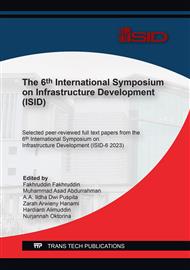[1]
A. Ślosarczyk, I. Klapiszewska, P. Jedrzejczak, L. Klapiszewski, and T. Jesionowski, "Biopolymer-Based Hybrids as Effective Admixtures for Cement Composites," Polymers (Basel), vol. 12, no. 5, May 2020.
DOI: 10.3390/POLYM12051180
Google Scholar
[2]
MNM, "Bioplastics & Biopolymers Market by Type (Non-Biodegradable/Bio-Based, Biodegradable), End-Use Industry (Packaging, Consumer Goods, Automotive & Transportation, Textiles, Agriculture & Horticulture), Region - Global Forecast to 2025," Markets and Markets.
Google Scholar
[3]
R. Prada, "Manfaat Polimer dalam Konstruksi Bangunan, Paling Banyak Digunakan di Eropa," Eticon.
Google Scholar
[4]
A. Setyawati, "Asean Pulp and Paper Industry: Challenges and Opportunities in Indonesia."
Google Scholar
[5]
F. Falah et al., "Pengaruh Lama Penyimpanan dan Pengenceran Lindi Hitam Terhadap Karakteristik Lignin Kraft Acacia mangium," Jurnal Riset Kimia, vol. 13, no. 2, p.138–151, Sep. 2022.
DOI: 10.25077/jrk.v13i2.506
Google Scholar
[6]
Lubis and A. Ariani, "Isolasi Lignin dari Lindi Hitam (Black Liquor) Proses Pemasakan Pulp Soda dan Pulp Sulfat (Kraft)," Institut Pertanian Bogor, 2007.
Google Scholar
[7]
O. Faruk and M. Sain, Lignin in Polymer Composites. United States of America: Matthew Deans, 2016.
Google Scholar
[8]
F. Falah, "Pemanfaatan Limbah Lignin Dari Proses Pembuatan Bioetanol Dari TKKS Sebagai Bahan Aditif Pada Mortar," Universitas Indonesia, Depok, 2012.
Google Scholar
[9]
K. Gopalakrishnan, H. Ceylan, and S. Kim, "Renewable Biomass-Derived Lignin In Transportation Infrastructure Strengthening Applications," International Journal of Sustainable Engineering, vol. 6, no. 4, p.316–325, Dec. 2013.
DOI: 10.1080/19397038.2012.730069
Google Scholar
[10]
K. C. Seto, B. Güneralp, and L. R. Hutyra, "Global Forecasts of Urban Expansion to 2030 and Direct Impacts on Biodiversity and Carbon Pools," Proc Natl Acad Sci U S A, vol. 109, no. 40, p.16083–16088, Oct. 2012.
DOI: 10.1073/pnas.1211658109
Google Scholar
[11]
H. H. M. Darweesh, "Extraction of Lignin from Wastes of Sugarcane Bagasse and Its Utilization as an Admixture for Portland Cement," NanoNEXT, p.13–27, Mar. 2021.
DOI: 10.34256/nnxt2113
Google Scholar
[12]
M. T. Safian, S. H. Sekeri, A. A. Yaqoob, A. Serrà, M. D. Jamudin, and M. N. M. Ibrahim, "Utilization of Lignocellulosic Biomass: A Practical Journey Towards The Development of Emulsifying Agent," Talanta, 2022.
DOI: 10.1016/j.talanta.2021.123109
Google Scholar
[13]
Y. Li, H. Zhu, C. Yang, Y. Zhang, J. Xu, and M. Lu, "Synthesis and Super Retarding Performance in Cement Production of Diethanolamine Modified Lignin Surfactant," vol. 52, p.116–121, Feb. 2014.
DOI: 10.1016/j.conbuildmat.2013.09.024
Google Scholar
[14]
Ł. Klapiszewski, I. Klapiszewska, A. Slosarczyk, and T. Jesionowski, "Lignin-Based Hybrid Admixtures and Their Role in Cement Composite Fabrication," Molecules, vol. 24, no. 19, 2019.
DOI: 10.3390/molecules24193544
Google Scholar


